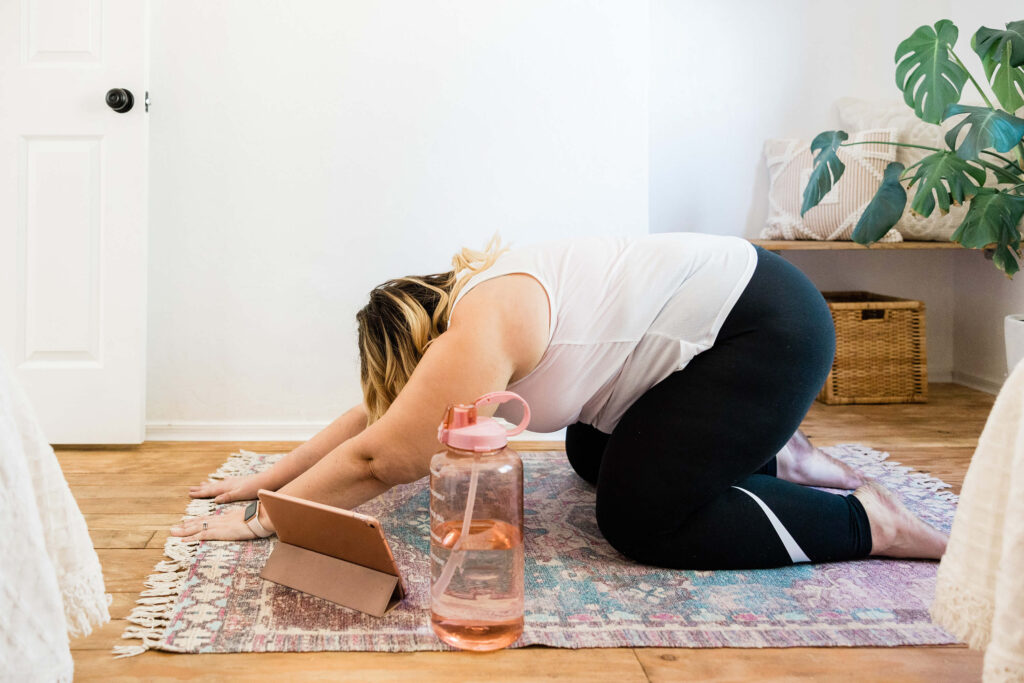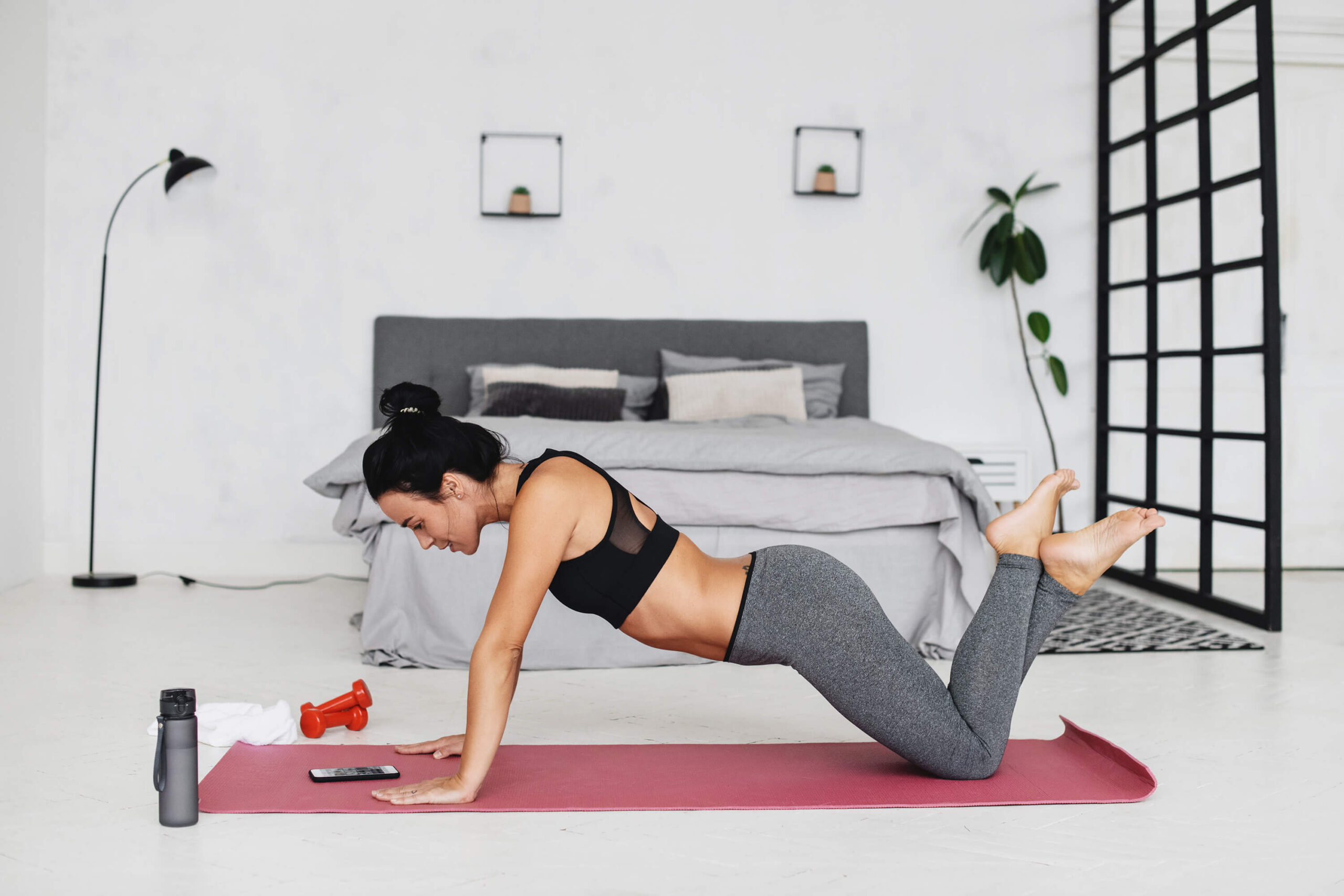Ever thought about becoming that person who effortlessly unrolls their mat at home for a regular yoga practice? If you’ve found it challenging to establish a consistent routine, don’t worry – you’re not alone. Let’s dive into some valuable tips that can kickstart your journey toward embracing a consistent and enjoyable home yoga practice.

Mastering A Yoga Home Practice
Imagine stepping into a space where the outside world fades away, where the rhythms of life slow down, and where the only agenda is your well-being. Welcome to the enchanting realm of home yoga practice, a place where your mat becomes your sanctuary, and each breath guides you closer to balance, strength, and tranquility.
While the allure of studio classes is undeniable, home practice holds its own unique charm. It’s a journey that invites you to explore yoga on your terms, delve deeper into your practice, and discover the boundless benefits of self-guided sessions. From sunrise flows to evening stretches, the world of home yoga practice is waiting to be woven into the fabric of your daily life.
So, here are 6 tips to bolster your home yoga practice:
1. Plan Your Practice Wisely
Just like scheduling work meetings, Skype calls, or any other appointments, you’re more likely to practice if you set aside dedicated time (pro tip: block it out in your calendar).
Just imagine – even practicing yoga once a week can bring about significant benefits! If you’re aiming higher, three times a week is a fantastic goal, and hey, if you’re up for it, practicing every single day is wonderful too. But here’s the secret: it’s all about what works best for you.
Whatever your goals around your home yoga practice are, it’s way better to meet a realistic schedule goal and feel proud than to set an ambitious daily goal that might leave you feeling disappointed with yourself. Remember, the feeling of failure can sometimes lead to the opposite result: skipping practices altogether.
So, let’s keep it real. Set goals that genuinely resonate with your schedule and commitments. Whether it’s a quick 10-minute practice or a longer session, each moment on your mat counts. The key is consistency, no matter the duration. It’s all about embracing what you can realistically achieve and celebrating each step of your yoga journey.
If you’re not a morning person, planning a workout at sunrise might not be your jam. Likewise, if you’re a busy mama, a pre-bed practice might not work for you either, but lunch might work great. Make life easy and follow your natural rhythm. If you’re working from home, take advantage of that as it’s easier to fit in a home practice whenever it suits you. Use recorded class videos, YouTube, and apps (such as Glo or Alomoves, Yoga International or You Aligned) for choice, range, difficulty, length and convenience.
2. Set A Goal
If starting seems daunting, focus on a goal. For instance, nailing a split, touching the ground with your hands, or holding Tree Pose for 3 minutes. There’s no shortage of poses and goals, and they can inspire you to create sequences or find classes that align with your objectives. Think about what it takes to achieve a specific pose, and explore if you’re unsure. Always warm up, work through relevant poses (like hip-openers, for instance), and end with relaxation or meditation.
A good way to just get on your mat when you don’t know where to start is just by moving through some sun salutations. They are super complete flows and you have different variations. Memorize one or two and get moving.
3. Listen to Your Body and Your Needs (Practice Safely)
With everything going on in the world, mental and emotional exhaustion can sneak up on us. Yoga is a practice of self-listening. Tune into your needs. Look inward and ask yourself what you need for your practice. Be honest, guided by the yogic principle of Satya (truth). If it’s rest and restoration, go for a more gentle, restorative home practice. If you’re craving a workout to release, opt for a Vinyasa or Power yoga class. When your home practice meets your needs, you’re more likely to make it a regular habit.
Always honor your boundaries, and pay extra attention to your body’s sensitive areas (joints and spine). If you experience any discomfort, modify, ease up, or exit the pose if necessary. Avoid forcing or pushing yourself.
Make sure to warm up thoroughly before attempting complex poses, and continually check if a pose feels right for you. Be extra cautious during transitions or when entering and exiting poses – these moments hold the potential for injury as we often overlook our alignment. Stay attentive to ensure a safe practice.

4. Reward Yourself
Some days, you just don’t feel like getting on the mat. But it’s crucial to move, especially in times of desk jobs where we’re very sedentary. By tapping into basic behavioral psychology, we can motivate ourselves with the promise of a reward for getting active. And we’ll be more likely to do it again. Choose to reward yourself after your practice. This post-practice reward could even prolong the well-being effects of your practice (as long as it’s not completely unhealthy, obvi).
5. Get the Right Gear and Setup
You don’t need much for yoga – basically, your body and a floor. But having a pleasant space and quality gear can be more motivating. Create an inviting corner with good lighting, ventilation, incense, music, or candles. A cozy setup can make you want to practice more often.
Consider investing in a good mat to avoid slipping during sweaty sessions or blocks, bolsters, and straps to enhance your practice. If you’re into dynamic practices that make you sweat, you’ll want a mat with good grip. If your preference is yin or restorative yoga, bolsters, cushions, and straps are essential.
Invest in your well-being. Opt for quality gear that will stand the test of time and use. Prioritize natural materials (rubber, bamboo, hemp, linen, etc.) and responsible brands (with high standards in manufacturing and employee treatment).
If you’re looking for such a brand, I recommend Manduka. My own rubber Manduka mat, bought over 4 years ago, has been serving me almost daily since. I have no regrets, and it’s still going strong. The initial investment was well worth it.
Other brands I love and have tested are Jade Yoga, Lifeforme, and Yoga Matters.
As a reader or a member of my yoga community, you can enjoy a 10% discount on Manduka’s catalog. Go to their website and use the code: SIMPLYSUEMAT at check out.
With all these tips, there’s no excuse not to practice at home, however, if you do need some help, consider investing in private yoga classes.
Keep calm and practice on, and let me know in the comments below what you struggle with when it comes to your home practice.
Want more great content and tips: Join my inner circle to stay updated with things I only share through email →







+ show Comments
- Hide Comments
add a comment